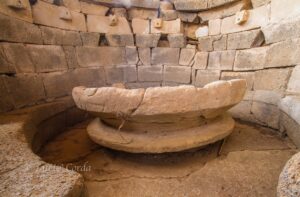“Literally means ‘point of passage for carts’, a name dating back to the activities of collecting firewood that characterized the site in the 19th and 20th centuries: it is a nuragic complex of exceptional architecture and engineering, created during the metalworking era and linked to the worship of water, a precious element in the arid limestone environment of”Supramonte, the Sardinian ‘dolomites’. The village ofthe Saddle of the Carrosit is set in the wildvalley ofLanaittu, a spectacular natural backdrop within the territory ofOliena, reachable from the road that leads (heading towards Dorgali) also to the national monument of the karst springthe Gologoneand to the splendid caves ofthe Caveandthe Wind…It was a time when man learned to extract and forge metals (bronze and iron), from which derive artifacts found in the numerous circular and oval-shaped huts that make up the village. One dwelling stands out for its unique architecture and ritual function: it is the ‘fonte’, a circular environment with internal walls made of bicolored squared blocks – white limestone and dark basalt – and with a carefully worked floor. On the walls are carved in high relief heads of mouflons with a hole through which water, coming from the channel carved into the wall thickness, gushed into the round monolithic basin in the center of the floor. Near the hut, you will see a large circular stepped structure: it was the basin for ceremonial ablutions, religious rites that involved the use of sacred water. This structure changed over time, becoming a storage place for bronze objects awaiting a new processing cycle… ” (Sardegna Turismo).
The village ofthe Saddle of the Carrosit is set in the wildvalley ofLanaittu, a spectacular natural backdrop within the territory ofOliena, reachable from the road that leads (heading towards Dorgali) also to the national monument of the karst springthe Gologoneand to the splendid caves ofthe Caveandthe Wind…It was a time when man learned to extract and forge metals (bronze and iron), from which derive artifacts found in the numerous circular and oval-shaped huts that make up the village. One dwelling stands out for its unique architecture and ritual function: it is the ‘fonte’, a circular environment with internal walls made of bicolored squared blocks – white limestone and dark basalt – and with a carefully worked floor. On the walls are carved in high relief heads of mouflons with a hole through which water, coming from the channel carved into the wall thickness, gushed into the round monolithic basin in the center of the floor. Near the hut, you will see a large circular stepped structure: it was the basin for ceremonial ablutions, religious rites that involved the use of sacred water. This structure changed over time, becoming a storage place for bronze objects awaiting a new processing cycle… ” (Sardegna Turismo).
The photos of the nuragic village Sa Sedda ‘e sos Carros in Oliena are by Maurizio Cossu and Lucia Corda.

